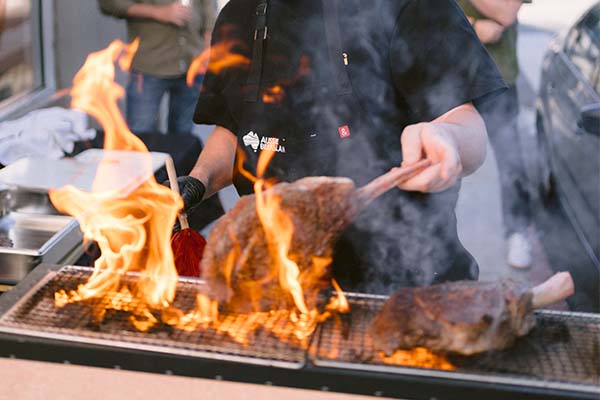In this instalment of our Meat the Supplier series, we speak with Paul da Silva, Regional Manager – North America for Meat & Livestock Australia (MLA). Based in Washington DC, Paul leads MLA’s efforts across the United States, Canada, and Mexico, working to build demand and market access for Australian red meat.

What is your role at MLA and where are you based?
I’ve spent about 15 years as a meat marketer, and the 15 years before that in broader marketing roles. Before joining MLA, I was with Stanbroke as their Marketing Manager, and prior to that, I was General Manager of Marketing and Brand at Hewitt, where I led the rebrand from Hewitt Cattle Australia to Hewitt. I also spent time at Arcadian Organic as Marketing Director, and earlier in my career, I worked with Rivalea in pork.
So, I’ve seen a fair bit of the supply chain, from pork to beef, and from branding to business development.
Now, as MLA’s Regional Manager for North America, I’m based in Washington, DC, but my remit covers the US, Canada, and Mexico.
What do your day-to-day operations look like for you and your team?
The vast majority of my job is marketing in one form or another. There are four main areas of responsibility: market access, which is a big focus right now, category branding, the Aussie Meat Academy, which is a broad educational program, and targeted business development.
We have a significant number of initiatives under each one of those pillars. All of that involves a mix of travel to different events, communications programs, and preparing content to educate or support our position with retailers and foodservice businesses. It is a full mix of marketing activity across the whole North American continent.
We have a small MLA team here, just five of us, but we work closely with a strong network of partners. Because North America is such a mature market, we need a different mix of skills and partnerships compared to developing markets. Much of our work is about supporting teams already here and providing the right resources to help them succeed.
Tell us a bit more about how you communicate the benefits of Australian meat to North American consumers.
One of the challenges we have here is that the US doesn’t have mandatory country-of-origin labelling for meat. Many organisations intentionally don’t put anything on the label, which gives them flexibility to source product from wherever is most commercially beneficial.
So, we are careful about where we invest in consumer-facing communications. We don’t want to overinvest in marketing something that consumers won’t actually be able to find or identify on the shelf!
To combat this, we are very considered with our channels, and focus a lot on influencing commercial buyers, retailers and foodservice operators, by showing them that consumers are looking for grassfed, sustainable products. We use a mix of social media, industry media, events, and direct engagement such as our Butcher Bar event held in May 2024. Where we can, we run campaigns in partnership with retailers.
 Steaks on the grill at the MLA Butcher Bar event
Steaks on the grill at the MLA Butcher Bar event
One of the strongest success stories has been in country of origin labelling for Australian lamb. The domestic lamb market is very small in the United States, particularly compared to their domestic beef market, but we think we have done well to build a positive reputation for our lamb over here, and we have had quite a bit of success with more and more retailers picking up Australian lamb.
How has the demand for Australian grassfed beef changed in the United States, and what is growing that demand?
There has been a real shift towards high-quality grassfed options across all meal types. There has been a lot of communication across the US, outside of what we are doing at MLA, around health and wellness, and a big part of that conversation has been in protein. With consumers increasingly focused on health, sustainability, and ethical production, demand for grassfed beef is going up.
Exporters are responding by providing more high-quality grassfed product in all formats, whether that be primal, portioned retail, or anything in between.
Our challenge and mission at MLA is to make sure people understand that if they want truly responsible, grassfed beef, Australia is at the centre of that offering. We are constantly reassuring consumers that the Australian product is the best to satisfy all of those criteria.
How has the recent change in US tariff policy affected the market, particularly in relation to Brazilian access being restricted, and what does that mean for Australia?
The increased tariff on Brazilian product only came into effect in August, so it’s still early days, but it has created a lot of uncertainty for importers. The advantage for Australia is that our tariff rate is at the lowest rate, at 10 per cent, so we’re still in a strong position compared to other markets. Our currency is also often in a favourable position, which can moderate the impact of tariffs. So as far as buyers are concerned, Australia is usually a good option.
Overall, demand for beef in the US remains very strong. The US is still eating a lot of beef, which they can’t produce by themselves, and Australia remains seen as a reliable, long-term partner.
What about the impacts of something like screw worm on the Mexican cattle herd?
The screw worm issue has tightened supply and increased reliance on imported beef. Australian product is there to reliably fill the gap. It’s just one more factor tightening domestic supply and increasing the importance of imports.
How does the US retail landscape differ from Australia’s, and what are the implications for Australian meat exporters?
The scale is the biggest difference. There are supermarket chains in the US that are bigger than Coles or Woolworths, but Australians have never even heard of them. Many are family-owned and regional, but still huge by Australian standards.
The market is immense and the retail infrastructure to support it is highly developed. That means we have to be very targeted with our resources and focus on where we can get the best results.
Are record lamb prices in Australia slowing the demand and/or growth of lamb in North America?
Prices are definitely flowing through to importers and distributors, but demand for Australian lamb remains resilient.
Lamb consumption in the US is up 57 per cent since 2011, and even though it’s still much lower than beef, there is a lot of potential for growth, and we’re seeing strong demand despite higher prices. Lamb imports from Australia were up 2 per cent in the first half of this year.
The key, I think, is putting lamb in familiar formats for people over here. For example, you can have Australian lamb meatballs at Cava, a mainstream retail chain, so consumers are comfortable trying it. Foodservice is a big driver, and getting lamb into everyday meals from there is where we see real volume growth.
Surprisingly, the market for goat is also increasing. Mostly it seems there are substantial communities in the US who have a heritage of eating goat, and those communities actively seek it out. You can find Australian goat in retail settings over here, you can purchase it at Costco for example.
What do you see as the biggest ongoing opportunities in North America for Australian producers?
The biggest opportunity for Australian producers in North America is the sheer scale of the market, which is also highly segmented and dynamic. There’s a massive foodservice sector, with thousands of brands and a strong culture of convenience and home delivery. Getting Australian beef and lamb into these everyday meal formats, things like burgers, burritos, and other ready-to-eat meals, drives real volume. For example, there are about 54 billion burger patties consumed in the US each year, and roughly 6 billion of those are Australian. Even a small shift in market share or consumer preference can mean a big increase in demand.
Another opportunity, as already mentioned, is that growing consumer focus on health and sustainability. US consumers are increasingly seeking out grassfed, grass-finished beef and lamb, and Australia is well positioned to meet that demand.
Canada is another market to watch. With zero tariffs on Australian product and strong partnerships developing with major retailers, there’s a lot of potential for growth in both foodservice and retail. The political and market access environment is favourable, and there are opportunities to get Canadian buyers to consider Australia for their needs.
Finally, opportunities aren’t just about selling more product—it’s about maintaining and building on Australia’s reputation for quality, integrity, and innovation. The US market values traceability, biosecurity, and animal welfare, and Australia’s systems are world-leading. By staying agile, listening to market signals, and continuing to invest in quality and sustainability, Australian producers can ensure they remain the supplier of choice in North America’s dynamic and opportunity-rich market.
What are some of the biggest issues or risks in the supply chain from your perspective?
I think one of the biggest risks is losing alignment between what the market wants and what we are producing in Australia. It’s vital to keep collecting and sharing insights all the way down the supply chain. Maintaining the integrity of our traceability and biosecurity systems is also crucial, and these are real points of difference for Australia.
Despite economic turbulence, demand is strong, and we’re on track for potentially our largest year ever for beef imports into the US. The risk is anything that compromises our ability to supply what the market wants; the opportunity is to keep focusing on what consumers value most.
Finally, what are some interesting facts about the supply chain or industry which growers may not know?
We are on track for a record year of exports to North America. To the end of July, we had already shipped 272,000 tonnes of beef. To put it in perspective, that is equivalent to the weight of almost three USS Nimitz aircraft carriers! It has gone into supermarkets, fabulous restaurants and literally billions of hamburgers.
